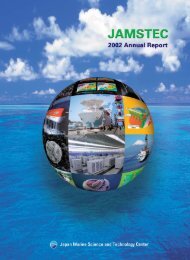2007 Annual Report - jamstec japan agency for marine-earth ...
2007 Annual Report - jamstec japan agency for marine-earth ...
2007 Annual Report - jamstec japan agency for marine-earth ...
Create successful ePaper yourself
Turn your PDF publications into a flip-book with our unique Google optimized e-Paper software.
and tropical <strong>for</strong>est was surveyed by satellite data, and its impact<br />
on the carbon cycle was investigated. Long term snow cover<br />
change, which influences vegetation phenology was also investigated.<br />
The study of the global relationships of vegetation-air<br />
temperature, vegetation-precipitation, and vegetation-PAR was<br />
developed<br />
AGCM. Main differences of this scheme from the past scheme<br />
are 1improved treatment of mixing length and 2pressure<br />
correlation terms, 3updated closure constants based on<br />
LES results and 4higher level in the hierarchy of the<br />
scheme. Main Improvements are seen in vertical distribution of<br />
water vapor and cloud water in the lower troposphere<br />
5Global Warming Research Program<br />
The principal goal of the Global Warming Research<br />
Program is projection and understanding of global warming.<br />
Working towards this goal, three groups, Global Warming<br />
Research Group, Coupled Model Development Group and<br />
Paleoclimate Research Group, are involved in numerical experiments<br />
<strong>for</strong> present day, future global warming and paleoclimate<br />
using the Earth Simulator, and in climate model development.<br />
As the IPCC AR4 process was over in FY2006, all groups<br />
have slightly adjusted their research plan with AR5 in mind.<br />
Members of the Global Warming Research Group are engaged<br />
in critical analyses of model outputs presented to AR4 in order<br />
to understand model per<strong>for</strong>mance better.<br />
The Coupled Model Development Group is engaged in<br />
studies to improve model physics in the CCSR/NIES/FRCGC<br />
Fig.1. Large dry biases around 850hPa are almost eliminated<br />
with this scheme. Low level clouds tend to be lifted up making<br />
the result closer to observations.<br />
A new cumulus parameterization is developed. Its main<br />
characteristics are 1 lateral entrainment rate changes vertically<br />
depending on buoyancy and vertical velocity of cloud air<br />
parcel, 2 updraft ensemble is spectrally represented according<br />
to updraft velocity at cloud base and 3 cloud base mass<br />
flux is determined by the same method as the prognostic<br />
Arakawa-Schubert scheme. The result shows great improvements<br />
such as 1equatorial moist Kelvin waves and MJOlike<br />
waves are represented without any empirical triggering<br />
schemes, 2double Inter Tropical Convergence Zone<br />
ITCZ disappearsFig.2in the eastern Pacific and 3<br />
South Pacific Convergence Zone SPCZ is well represented.<br />
Atmosphere Ocean Coupled General Circulation Model<br />
hence<strong>for</strong>ce, this model is called MIROC, and the atmospheric<br />
part of it MIROC AGCM and to clarify characteristics of<br />
model biases. This group is a core group of the coupled model<br />
development at FRCGC, and members of the other groups of<br />
GWRP as well as other programs at FRCGC have joined in the<br />
activities.<br />
The Paleoclimate Research Group is engaged in various<br />
numerical experiments, on the onehand, to understand the<br />
mechanisms of paleoclimate changes and on the other, to verify<br />
b. Change in climate sensitivity by the improvement of atmospheric<br />
boundary layer in MIROC<br />
Since we plan to use MIROC, described above, <strong>for</strong> the<br />
comprehensive global warming research, we have examined the<br />
climate sensitivity the equilibrium change in global mean<br />
surface temperature following a doubling of the atmospheric<br />
CO 2 concentration which is a useful measure to identify and<br />
characterize a GCM. We have found that the higher-order closure<br />
scheme has a large influence on the climate sensitivity<br />
MIROC, strengthening cooperation with other related research<br />
groups.<br />
Research Results<br />
a. Improvement of boundary layer and cumulus parameterization<br />
An improved version of Mellor-Yamada scheme based on<br />
Nakanishi and Niino 2004 is implemented in MIROC<br />
Fig.1 Zonally averaged annual mean specific humidity bias in the<br />
experiment with old left and new right scheme.
















